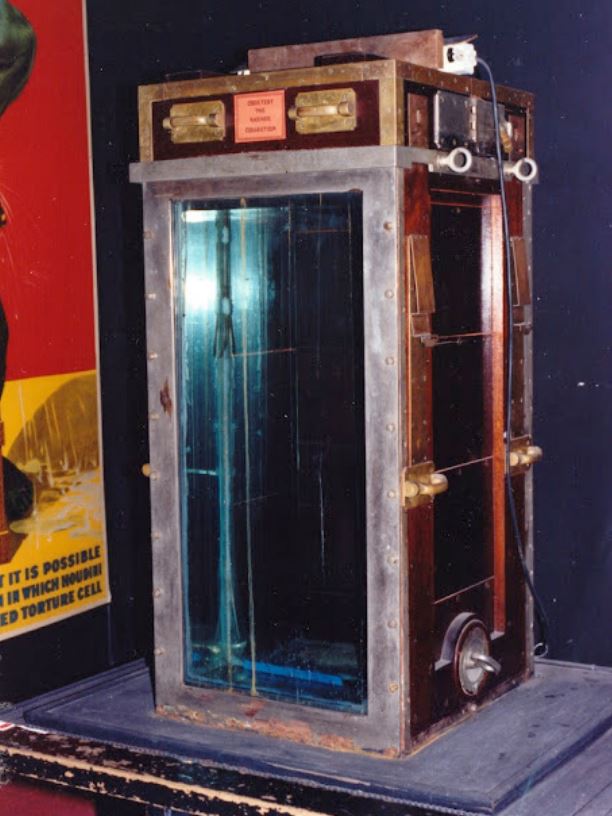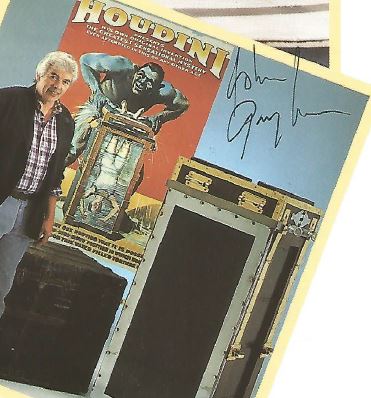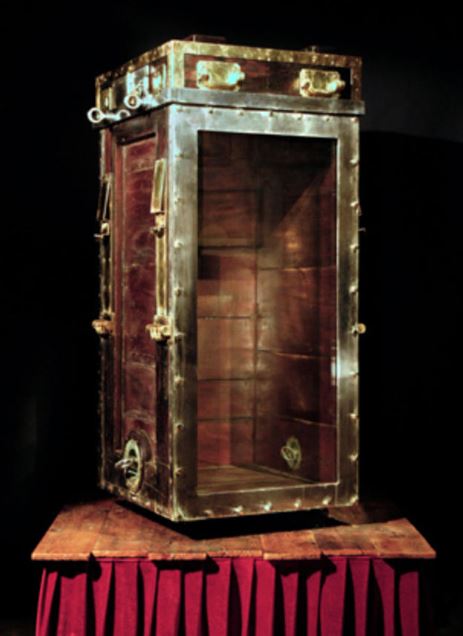
|
|
|
|
|
|
The Houdini Water Torture Cell has been performed! Click here for the video!In November 2019 we made the most incredible purchase. At the time of purchase, we were unaware of the historical significance of what we had found. To give some history: Harry Houdini is famous for being the man no jail or restraint could hold. His most famous and spectacular escape was the Chinese Water Torture Cell. In the Chinese Water Torture Cell an upright tank of water was placed on stage. Houdini's feet were secured in a set of stocks and he was lifted upside-down. He was lowered - head first - into the water tank and the stocks were locked to the tank. Many people know a bit about Houdini but for those who don't here is a quick history. Erik Weisz was born in Budapest, Hungary on March 24 1874 and his family immigrated to the United States that same year. His father died when Erik was very young and to help support his family he began performing. He adopted the stage name Harry Houdini. Harry was a play on his nickname pronounced "Errie" and Houdini was in tribute to Robert-Houdin who was a famous French magician. Houdini publicly stated that his birthday was April 6 1874 and it is thought that the reason for this was so he would be viewed as a 'true' American and not an immigrant. 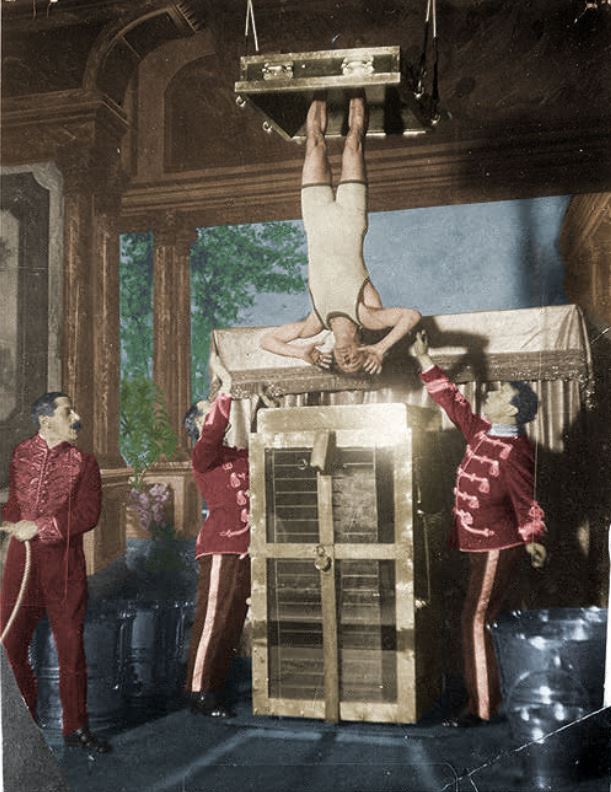
In the beginning Houdini struggled to earn a living performing magic and it wasn't until he added escapes to his act that he began to experience success. He took Europe by storm in the early 1900's and became a sensation by accepting and beating any challenge to be restrained. These challenges included jail escapes, handcuff escapes, strait jacket escapes, mail bag escapes and many more. Tired of imitators, Houdini created the Chinese Water Torture Cell which was the pinnacle of all of his previous escapes. Over the years the Chinese Water Torture Cell has become known as the Water Torture Cell. Houdini performed the Water Torture Cell from 1912 to his death on Halloween night in 1926. Contrary to popular belief, Houdini did not die performing his Water Torture Cell. Instead, he died of peritonitis caused by a ruptured appendix. It was Houdini's request in this last will and testament that all of his props be destroyed after this death, but they were not. Houdini's brother, Theo, who performed under the stage name Hardeen, took possession of the Water Torture Cell after Houdini's death. Hardeen was much taller than Houdini and was not able to fit inside the Water Torture Cell to perform it himself. From what we understand, Hardeen sold the Water Torture Cell to Hardeen's protégé, a carpet salesman named Sid Radner in 1942. Sid Radner had aspirations to perform the Water Torture Cell but never did. The WTC was stored in the basement of Sid Radner's mother's house and many of the elite in magic came by to view it. In 1970 the Water Torture Cell was put on display in The Houdini Hall of Fame which was a museum in Niagara Falls, Canada. The original museum moved to a new location in 1971 and the Water Torture Cell was moved to the new locations along with all the other paraphernalia.
The Water Torture Cell remained in The Houdini Hall of Fame until 1991 when it was removed to be restored. John Gaughan won the contract to restore the badly damaged and neglected Water Torture Cell and it was shipped to Los Angeles, California, USA. After restoration the Water Torture Cell was returned to the museum.
Thanks to Ron Mangano for sending us the picture above Feb 19 2021 from the Magic Magazine article. The museum was scheduled to close in 1996. Prior to closing there was a suspicious fire in the museum. Basically all that burned was the Water Torture Cell. An insurance settlement was later collected. The charred remains of the Water Torture Cell were sent back to John Gaughan. Repair or restoration was not possible due to the sever damage caused by the fire. Approximately 90% of the Water Torture Cell had to be rebuilt. 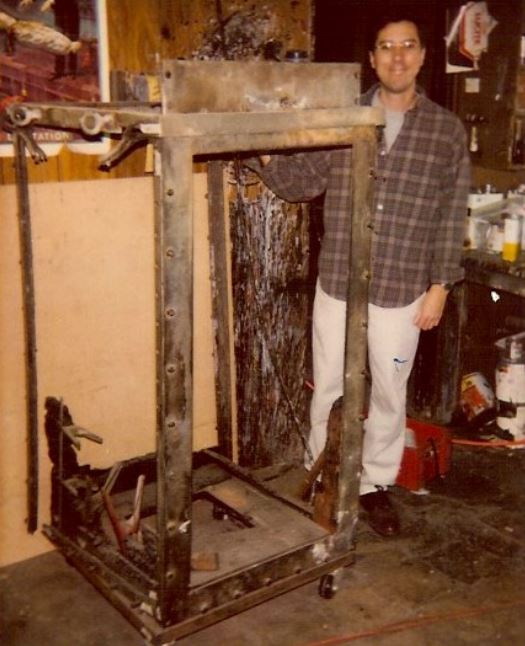
The remains of the Water Torture Cell after the fire.By the time the rebuild was complete the museum had closed. 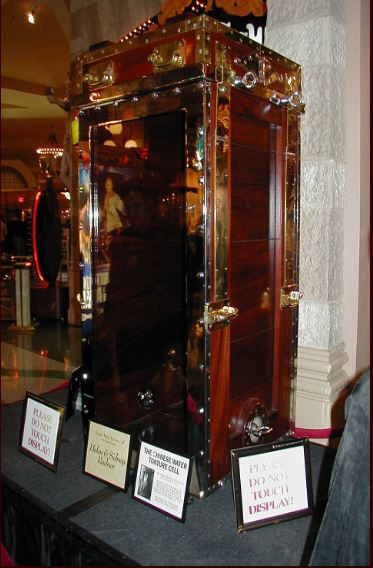
The rebuilt Water Torture Cell after the fire.Sid Radner displayed the Water Torture Cell in Las Vegas, Nevada, USA in 2002. In 2004, Sid Radner sold the Water Torture Cell and other Houdini props he had in his collection in an auction that had the magic community a buzz. David Copperfield purchased the Water Torture Cell along with a number of other items. It was initially reported that he paid $300,000 for the Water Torture Cell however insiders later claimed that $150,000 was paid for the Water Torture Cell and the remaining $150,000 was for the other items he purchased. Since the purchase at the auction, David Copperfield had his team deconstruct and rebuild the Water Torture Cell. His team used reclaimed 100-year-old mahogany wood and replaced the screws. It now sits in David Copperfield's museum and is available for viewing by private invitation only.
Over the years Houdini I had various versions of his Water Torture Cell created. Upon his death it is unknown exactly how many Cells existed. It was rumored that one Cell was left to rot in the backyard of Marie Hinson who was Bess Houdini's sister. It is speculated that a Cell was created for a female performer named Miss Trixie that Houdini sponsored to compete against an imitator named Miss Undina. This brings us back to our purchase in November 2019. Dayle Krall is known as The Houdini Girl and was contacted by a seller from Ontario, Canada who asked if we would be interested in purchasing a magician's water tank. The price was $10,000 and after seeing pictures we did not hesitate. When we received the tank we found that it was a Water Torture Cell. This Water Torture Cell does not appear to fit into the commonly accepted timeline of the Water Torture Cell that we have documented above. Water Torture Cell DeconstructionWe pulled the WTC out of storage and discovered its worsening condition. We pulled the entire Cell apart to look for any further mold and mildew between the panels and the frame and in the process removed almost 700 screws and 65 bolts. Many of the heads of the bolts had been extremely stripped. To preserve the Cell, we sent all metal and brass parts to be cleaned and clear coated to help preserve them. We applied a mold inhibitor (Concrobium Mold Control) to the inside wood to prevent further decay. We found an easy hack to clean the screws using Coca Cola. To clean the outside wood sections of the WTC we used a heat gun to strip off the layers of old wax with a plastic putty knife. This process did not damage the wood in any way, and we were very happy with this, but it filled in a lot of the screw holes and interesting characteristics in the wood which we regret. Here is a picture of the frame of the Cell after we had removed the panels, the glass and the wax had been removed with a heat gun. 
Another picture we would like to share is of the Cell being prepared to be reassembled. We received the metal back and were beginning to re-attach the hardware to the panels prior to reassembling which can be seen in this picture. 
Reassembly of the WTCFollowing is a sequence of the manner that we reassembled the WTC. This picture is of the very bottom of the WTC. This is the outside bottom that would sit on the stage.
The inside bottom piece of wood sits on the outside bottom framework that was shown in the previous picture. This is the wood that would have been under water. 
These two panels are attached together with bolts and then bolted to the base making a solid structure. 
The third panel is fastened in the same manner. 
Here is another picture of the inside. 
The 3/8" thick metal plate is attached to the top of the front. It is massive and heavy. 
Here is a picture of another angle of the assembled Cell. 
Here is a picture of the assembled Cell with the front glass, metal and stocks. 
Here is another picture of the fully assembled Cell but from a different, often unseen, angle. 
Here is a picture of the back of the Cell. The back of the WTC is even more rarely seen in photographs. 
Here is an interesting shot taken through the stock hole. 
DiscoveriesDuring the process of reassembling, we have had many new discoveries which we would like to share. When we removed the large hasp that locks the stocks, we discovered another set of screw holes behind it. We found this curious. 
Another discovery that we found earlier and wanted to share again for those who had not seen it. As Richard took the brass plate off of one of the locks and was looking at the lock, he noticed that there was something wedged between the lock case and the cut out in the wood of the stocks. After removing it he found that it was a 1909 British coin. It looks like this coin was being used as a shim and would have been installed when the stocks were built. We wonder who put that coin there and why? The interesting part is that the WTC was built in Britain around 1910-1911. 
It is also extremely peculiar that there are four Collins locks on the stocks. Does anyone have any ideas why there would be four instead of just two?
Lifting Ring PuzzleThe lifting ring is made from 5/16" thick, 1 1/2" x 1 1/4" angle iron. It appears to be cast and weighs a ton. Richard has always found it curious why the lifting ring had cut outs in it to accommodate the large hasps that fasten the stocks to the Cell. The hasps are bent in a way that they will pass over the lifting ring so why the cut outs? It is Richard's belief, that there was an error made during the construction and the thickness of the lifting ring was not considered. Richard believes this because the cut outs in the lifting ring are just a little bit deeper than the thickness of the metal of the ring. The slots were cut down 3/8" deep. Does anyone else have any other ideas why this would be the way it is? Ring HooksOne of the large ring hooks came off. It would not fit back into the hole in the lifting ring. It appears that the ring hooks were heat fitted - where the hole in the lifting ring frame was heated and the ring shaft was put into the hole and when it cooled down it was a perfectly tight fit. Two Expectional DiscoveriesThis picture shows how the panels are joined together using lap joints. It appears that there was some kind glue or sealant of some sort that was put in between the lap joints to help prevent water leakage. 
When we were assembling the 5 panels on the right side of the Cell, Dayle noticed that the centre panel was different. Upon further inspection we noticed a couple of things. One, the lap joints were clean. There wasn't any residue on the joint. Two, the corners of the joint were perfectly straight whereas the corners of the rest of the panels were ever so slightly rounded. This leads us to believe that this panel may have been replaced at some point in time. 

Here we have a real bombshell. One day when Richard was polishing the glass inside the Cell he dropped the Windex bottle and noticed that the bottom back panel moved. After examining the bottom panel, it was discovered that between the lap joints was a metal tube. This tube could be lifted vertically and it is believed to be a breathing tube. Of course, we do not know if this had ever been used. The board was spring loaded so it would pop open if hit at the back. We won't go into the complete description of it right now, but it is almost something out of James Bond. In the picture, Richard replaced the steel spring that had decayed into two pieces just to see how this worked. He thinks this is how it would have worked. 
This Cell has a working gaff and John Cox has the pictures to verify it but we will not be including those pictures for public release. We tried to remove the wood rings that surround the drain valves but couldn't. We had to remove the drain valves first because there was a membrane attached to the wooden rings. This, of course, made total sense to prevent leakage. We also noticed on a couple of screws that there was steel wool wrapped around them. This was often used when a screw thread was starting to wear to tighten it. The frames of the Cell were constructed with mortise and tenon joints. This was noticed because one of the joints had come loose. It was also very curious that on the back panel of the Water Cell, the panel themselves were opposite. The lap joints were opposite compared to the other two sides because the screws of each panel were installed above the seam whereas they were installed below the seam on the other two sides. There are also two diagonal gouges in the back panel. Both near the third bolt from the top on each side. These gouges are possibly from a chain that was wrapped around a Cell when moving it. We are not certain of this, but this explanation matches the gouges perfectly. Missing Items When we received this Cell we noticed that there were a few thing missing:
After reassembling the Cell and having developed a much better sense of how it was built and works we are wondering, now more than ever, where this Mystery WTC came from. With the discrepancy between the measurements Dave Dorsett provided of the WTC in the Niagara Falls museum and the measurements we had of the Mystery WTC we had no idea what the Mystery WTC was and where is came from. It wasn't until Richard had discussed the Mystery WTC with Dean Gunnarson that new information came to light. Dean provided the precise measurements and dimensions of the WTC that James Randi had drawn up of the Cell that was first delivered to the Niagara Falls museum in 1970. These measurements and dimensions match the Mystery WTC exactly and they are not the same measurements that the Cell in the museum had after the museum moved locations. Just to name a few discrepancies between the two Cells:
|
The Houdini Water Torture Cell has been performed!
To keep the Cell's historical value and to protect it we manufactured a Plexiglas insert to line the inside of the Cell. It is this insert that gets filled with water thus no damage will be done to this incredible historical piece.
